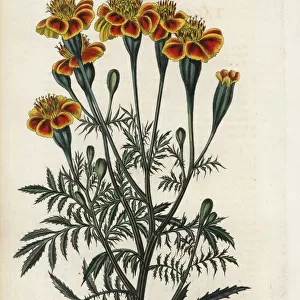Lychnis chalcedonica, Maltese cross
![]()

Wall Art and Photo Gifts from Mary Evans Picture Library
Lychnis chalcedonica, Maltese cross
Plate 26 from Ladies Flower Garden Annuals (1843) by Jane Wells Loudon. Also shows Coronata, Fulgens, Agrostemma Saponaria and Gypsophylla
Mary Evans Picture Library makes available wonderful images created for people to enjoy over the centuries
Media ID 8621565
© Mary Evans Picture Library 2015 - https://copyrighthub.org/s0/hub1/creation/maryevans/MaryEvansPictureID/10708655
1807 1858 Bloom Caryophyllaceae Caryophyllales Eudicot Jane Wells Jane Wells Loudon Loudon Lychnis Maltese Angiospermae Dicot Dicotyledon Magnoliophyta Maltese Cross
EDITORS COMMENTS
Plate 26 from Ladies Flower Garden Annuals (1843) by Jane Wells Loudon showcases a stunning arrangement of five different flowering plants, with the Maltese cross (Lychnis chalcedonica) taking center stage. This exquisite botanical illustration offers a glimpse into the Victorian era's fascination with the natural world and the beauty of flowering plants. The Maltese cross, also known as Lychnis chalcedonica, is a herbaceous perennial that belongs to the Caryophyllaceae family, order Caryophyllales, and class Magnoliophyta. It is an angiosperm, a type of seed-producing flowering plant, and a dicot, meaning it has two seed leaves. The plant is native to the Mediterranean region and is characterized by its distinctive red, five-petaled flowers, which resemble a Maltese cross. Surrounding the Maltese cross are four other flowering plants. The Coronata, with its delicate pink blooms, is likely a variety of Gypsophila, a genus of flowering plants in the Caryophyllaceae family. The Fulgens, with its vibrant yellow flowers, is most likely a type of Agrostemma, a genus of herbaceous plants in the same family. The Saponaria, with its bell-shaped blue flowers, is a member of the Caryophyllaceae family, and the Gypsophylla, with its small, white flowers, is likely a variety of the same name, also known as baby's breath. This botanical illustration, created in the 19th century by Jane Wells Loudon, offers a captivating glimpse into the beauty and diversity of the flowering plant world during a time when botany was a popular pastime and hobby for many. The intricate details and vibrant colors of the illustration serve as a testament to the dedication and skill of the botanical artists of the time and the enduring allure of the natural world.
MADE IN AUSTRALIA
Safe Shipping with 30 Day Money Back Guarantee
FREE PERSONALISATION*
We are proud to offer a range of customisation features including Personalised Captions, Color Filters and Picture Zoom Tools
SECURE PAYMENTS
We happily accept a wide range of payment options so you can pay for the things you need in the way that is most convenient for you
* Options may vary by product and licensing agreement. Zoomed Pictures can be adjusted in the Cart.






